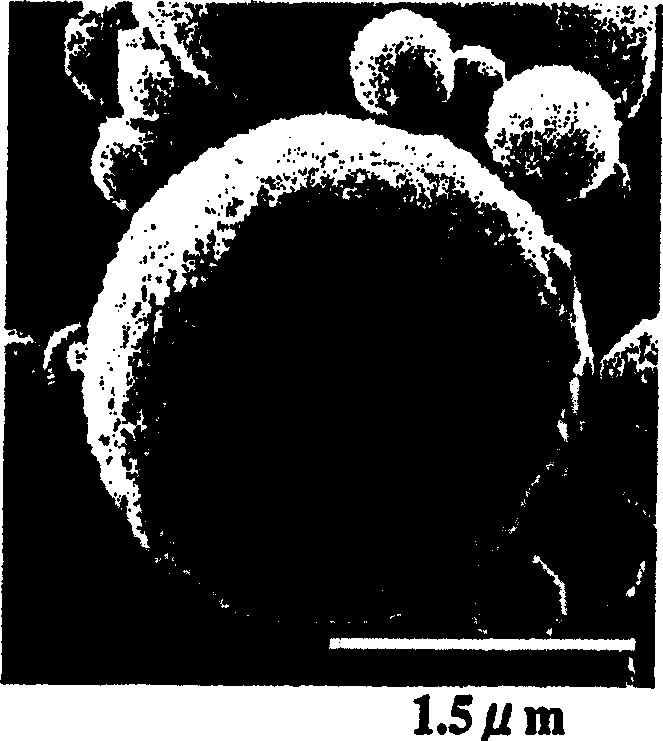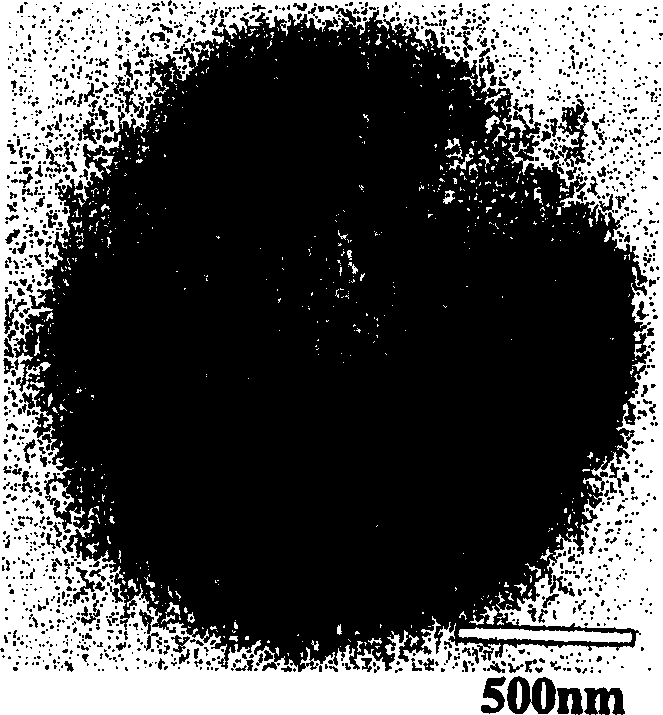Composite polymer particle and method for preparing same
A composite polymer and particle technology, which is applied in pharmaceutical formulations, cosmetic preparations, toiletry preparations, etc., can solve the problems of inability to obtain defense effects, usability and transparency, etc.
- Summary
- Abstract
- Description
- Claims
- Application Information
AI Technical Summary
Problems solved by technology
Method used
Image
Examples
Embodiment 1
[0102] Using a glass bead mill, 60 g of silicon-treated zinc oxide (MZ-507S) manufactured by Teika was stirred for 3 hours in 45 g of lauryl methacrylate (SP value 8.7) and 45 g of ethylene glycol dimethacrylate (manufactured by Otsuka Electronics Co., Ltd. The average particle diameter of zinc oxide measured by ELS-8000 is 0.3 μm). Thereafter, 3 g of lauroyl peroxide were added. 20 g of sodium lauryl sulfate was dissolved in 1500 g of ion-exchanged water, added to the above-mentioned zinc oxide slurry, and dispersed using a Mielder (the average particle diameter of the emulsion measured with LA-910 manufactured by Horiba Seisakusho was 1.6 μm). Next, put the dispersion into a 2000mL separable beaker, replace it with nitrogen, and heat up to 70°C while stirring at 200r / min, keep it at 70°C for 10 hours, then raise the temperature to 80°C, and heat up to 80°C under nitrogen at 80°C. Polymerization was carried out under atmosphere for 10 hours. After the polymerization, the so...
Embodiment 2
[0105] Using a glass bead mill, 90 g of Teika silicon-treated zinc oxide (MZ-507S) was mixed with 45 g of octadecyl methacrylate (SP value 8.7), 45 g of 1,6-hexanediol dimethacrylate, and 30 g of heptane. Stirring was carried out for 3 hours (the average particle diameter of zinc oxide measured with ELS-8000 manufactured by Otsuka Electronics Co., Ltd. was 0.4 μm). Thereafter, 3 g of lauroyl peroxide were added. Dissolve 15 g of sodium cocoyl methyl taurate in 1500 g of ion-exchanged water, add it to the above-mentioned zinc oxide slurry, and disperse it using a homogenizer (the average particle diameter of the emulsion measured with LA-910 manufactured by Horiba Manufacturing Co., Ltd. is 1.6 μm) ). Next, put the dispersion into a 2000mL separable beaker, replace it with nitrogen, and heat up to 70°C while stirring at 200r / min, keep it at 70°C for 10 hours, then raise the temperature to 80°C, and heat up to 80°C under nitrogen at 80°C. Polymerization was carried out under a...
Embodiment 3
[0107] Using a glass bead mill, 40 g of silicon-treated zinc oxide (MZ-507S) manufactured by Teika was stirred for 3 hours in 30 g of lauryl methacrylate (SP value 8.7) and 30 g of ethylene glycol dimethacrylate (manufactured by Otsuka Electronics Co., Ltd. The average particle diameter of zinc oxide measured by ELS-8000 is 0.3 μm). Thereafter, 1.5 g of 2,2'-azobis-2,4-dimethylvaleronitrile were added. Dissolve 30g of polyvinyl alcohol (EG-30 manufactured by Nippon Synthetic Chemical Industry Co., Ltd.) and 1g of sodium stearyl methyl taurate in 500g of ion-exchanged water, add them to the above-mentioned zinc oxide slurry, and disperse them using Mielda- (made by Dokujo Works). The average particle diameter of the emulsion measured by LA-910 is 2.0 μm). Next, put the dispersion into a 1000mL separable beaker, replace it with nitrogen, heat up to 60°C while stirring at 200r / min, keep it at 60°C for 2 hours, then raise the temperature to 80°C, Polymerization was carried out u...
PUM
| Property | Measurement | Unit |
|---|---|---|
| particle size | aaaaa | aaaaa |
| thickness | aaaaa | aaaaa |
| particle diameter | aaaaa | aaaaa |
Abstract
Description
Claims
Application Information
 Login to View More
Login to View More - R&D
- Intellectual Property
- Life Sciences
- Materials
- Tech Scout
- Unparalleled Data Quality
- Higher Quality Content
- 60% Fewer Hallucinations
Browse by: Latest US Patents, China's latest patents, Technical Efficacy Thesaurus, Application Domain, Technology Topic, Popular Technical Reports.
© 2025 PatSnap. All rights reserved.Legal|Privacy policy|Modern Slavery Act Transparency Statement|Sitemap|About US| Contact US: help@patsnap.com



